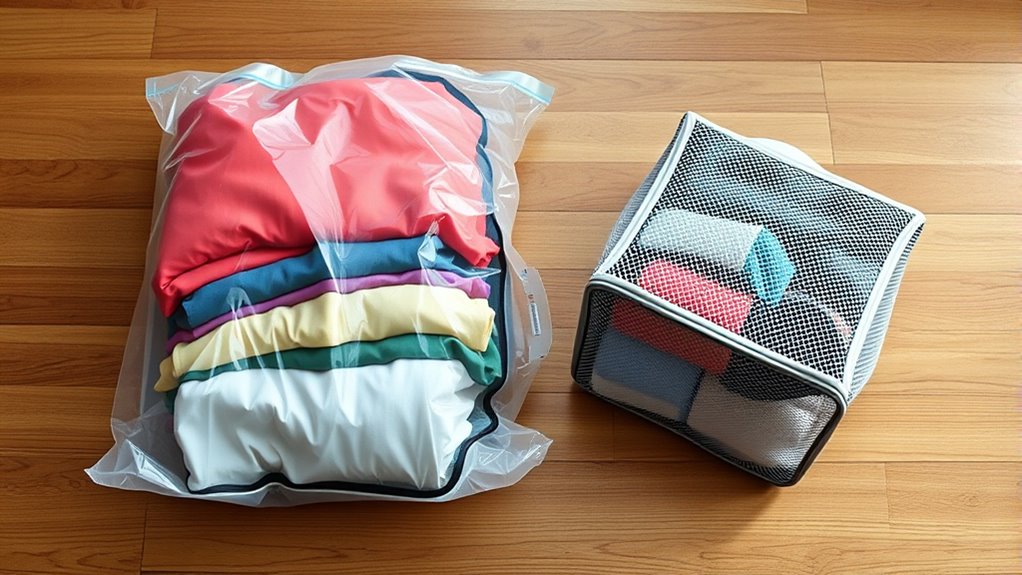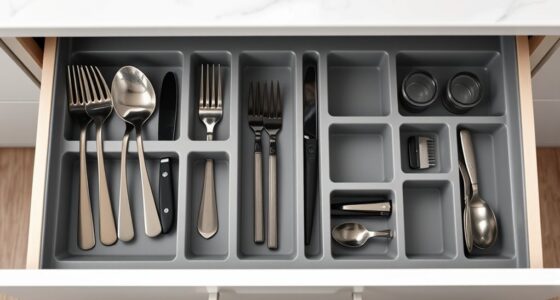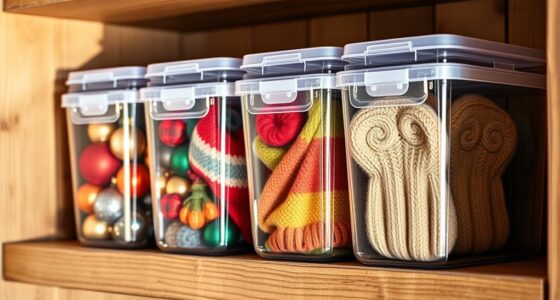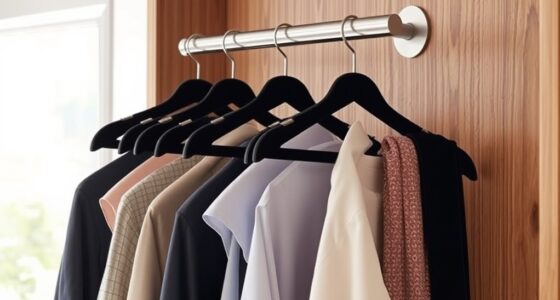If you’re looking to save space, vacuum storage bags are great for compressing bulky, long-term items like comforters or seasonal clothes, especially when you want to protect against dust and moisture. On the other hand, compression cubes are perfect for organizing and quickly accessing your belongings during frequent use or travel. Consider your priorities—maximizing space or enhancing organization—and keep exploring to discover which solution suits your needs best.
Key Takeaways
- Vacuum bags maximize space by removing air for long-term storage of bulky items, while compression cubes organize belongings for easy access.
- Vacuum bags require a vacuum or pump, whereas compression cubes rely solely on manual squeezing or rolling.
- Vacuum bags offer environmental protection against dust, moisture, and pests, unlike compression cubes.
- Compression cubes are more convenient for frequent use and travel, providing quick access without special equipment.
- Combining both methods optimizes space-saving and organization for different storage needs and durations.
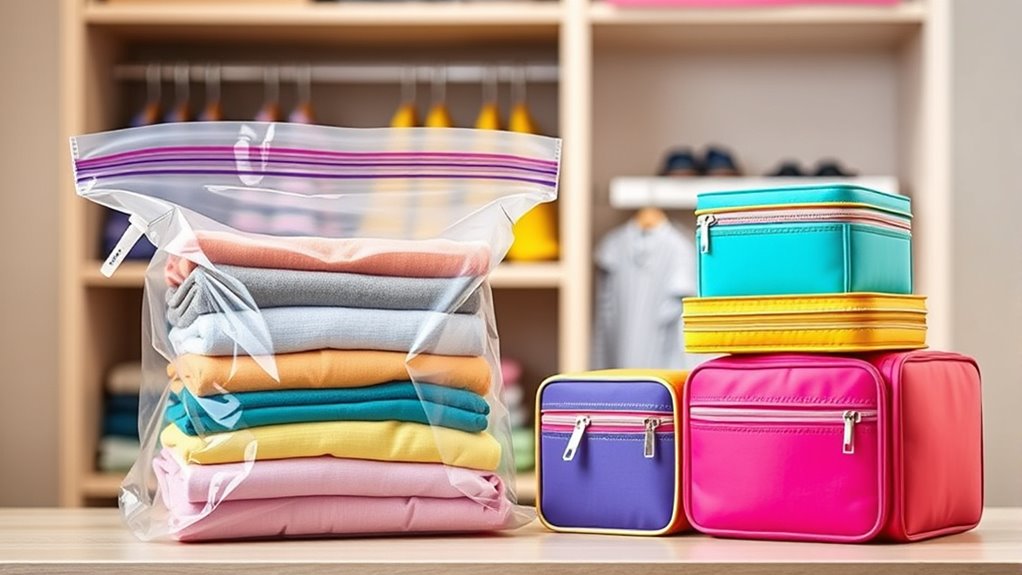
When it comes to maximizing closet space and keeping your belongings organized, vacuum storage bags and compression cubes are two popular options. Both can substantially enhance your space-saving tips and boost packing efficiency, but they serve slightly different purposes. Understanding how each works will help you decide which is best suited for your needs. Vacuum storage bags are designed to remove excess air from your items, compress them tightly, and create more room in your closet or luggage. You typically seal your garments inside the bag, then use a vacuum cleaner or a manual pump to extract the air, resulting in a flatter, denser bundle. This method is especially effective for bulky items like comforters, jackets, or seasonal clothing, allowing you to store more in less space. The key advantage is that vacuum bags protect your belongings from dust, moisture, and pests, making them ideal for long-term storage. Additionally, they can help preserve the integrity of sensitive items by reducing exposure to environmental factors.
On the other hand, compression cubes are fabric containers with built-in zippers that help you organize and compress your clothes without the need for a vacuum. You pack your items into the cube, zip it up, and then squeeze or roll to remove excess air. These cubes excel at packing efficiency because they are designed with multiple compartments, making it easier to categorize your belongings. They also keep your items neat and accessible, which is a big plus if you frequently travel or need quick access to specific items. Unlike vacuum bags, compression cubes don’t require special equipment, so they’re more convenient for on-the-go use. They also tend to be more durable and reusable over time, making them a reliable choice for regular packing.
Choosing between vacuum storage bags and compression cubes depends on your priorities. If you’re looking to maximize space in your closet or storage unit and want protection from external elements, vacuum storage bags are your best bet. However, if organization, quick access, and ease of use are more important, then compression cubes offer a smarter solution. It’s worth noting that integrating both can give you the most versatile storage system—using vacuum bags for long-term storage of bulky items, and compression cubes for everyday packing or travel. By understanding the strengths of each, you’ll improve your space management and packing efficiency, making your life a lot easier when it comes to organizing and storing your belongings. For instance, some electric bikes are designed with compact storage in mind, which can be useful for travelers or those with limited space.
Frequently Asked Questions
Are Vacuum Storage Bags Safe for Delicate Fabrics?
Vacuum storage bags can be safe for delicate fabrics if you take proper precautions. You should avoid excessive fabric stretching and verify the bags are designed for delicate materials. Check the chemical safety of the bags to prevent any damage or allergic reactions. When used correctly, they won’t harm your fabrics and help save space, but always follow the manufacturer’s instructions to keep your delicate items in pristine condition.
Can Compression Cubes Be Used for Non-Clothing Items?
You can definitely use compression cubes for non-clothing items, but consider their storage capacity and material compatibility first. These cubes work well for bedding, towels, or soft toys, helping you save space efficiently. Just make certain the items fit comfortably without overstuffing, and avoid fragile or heavy materials that might get damaged or break the cube’s structure. Always check the cube’s specifications to match your items properly.
How Long Do Vacuum-Sealed Bags Maintain Their Seal?
Vacuum-sealed bags typically maintain their seal for about 1 to 2 years, depending on storage conditions. You should check for any leaks or air re-entry regularly to guarantee your items stay fresh. Proper sealing techniques and storing them in a cool, dark place can extend the seal longevity and storage duration. Keep in mind, over time, seals can weaken, so periodic inspection is essential for long-term preservation.
Are There Size Limitations for Compression Cubes?
When considering compression cubes, you’ll find size limitations depend on their bag material and storage capacity. Most cubes are designed to fit within standard luggage or closet spaces, but larger options may be limited by thicker or less flexible materials. Check the product details to guarantee the cube’s dimensions match your storage needs, and choose a bag material that offers durability without sacrificing flexibility for easy packing.
Which Option Is More Environmentally Friendly?
Think twice before jumping to conclusions—when it comes to eco-friendly options, compression cubes often take the cake because they’re reusable and require less energy to produce and recycle. Vacuum storage bags, especially single-use ones, can be less sustainable. If you want to practice sustainable habits, choose compression cubes made from eco-friendly materials, and always look for brands committed to sustainable practices, helping you reduce waste and carbon footprint.
Conclusion
So, whether you choose vacuum storage bags or compression cubes, remember that both promise to save space—yet somehow, your closet still feels full. Ironically, no matter what you pack, clutter has a knack for finding a way back. Maybe the real trick isn’t in the storage method but in mastering the art of letting go. After all, no bag or cube can truly contain the chaos of your wardrobe—only your willingness to declutter.
